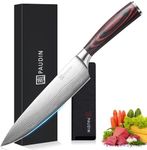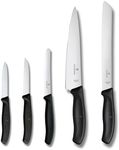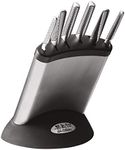Buying Guide for the Best Kitchen Knives
Choosing the right kitchen knife can greatly enhance your cooking experience, making food preparation easier, safer, and more enjoyable. The key to selecting the perfect knife is understanding the different types available and how their specific features can meet your cooking needs. Consider what you cook most often, your skill level, and how comfortable you are with handling knives. A good knife should feel balanced in your hand and suit the tasks you perform most frequently in the kitchen.Blade MaterialThe blade material of a kitchen knife affects its sharpness, durability, and ease of maintenance. Common materials include stainless steel, carbon steel, and ceramic. Stainless steel is resistant to rust and easy to maintain, making it a popular choice for everyday use. Carbon steel is sharper and holds its edge longer but requires more care to prevent rust. Ceramic blades are lightweight and stay sharp for a long time but can be brittle. Choose stainless steel for low maintenance, carbon steel for sharpness, or ceramic for lightweight handling.
Blade TypeBlade type refers to the shape and design of the knife's edge, which determines its suitability for different tasks. Common types include straight edge, serrated edge, and granton edge. Straight edges are versatile and ideal for precise cuts, while serrated edges are great for slicing bread and soft fruits. Granton edges have dimples that reduce friction and prevent food from sticking, making them suitable for slicing meats. Consider what you cook most often; a straight edge is a good all-rounder, while serrated and granton edges are specialized for specific tasks.
Handle MaterialThe handle material of a kitchen knife affects comfort, grip, and durability. Common materials include wood, plastic, and composite. Wooden handles offer a traditional look and comfortable grip but require more care to prevent damage. Plastic handles are durable and easy to clean, making them suitable for everyday use. Composite handles combine materials for enhanced grip and durability. Choose a handle that feels comfortable in your hand and suits your aesthetic preference, keeping in mind the level of maintenance you're willing to perform.
Knife SizeKnife size refers to the length of the blade, which affects its versatility and ease of use. Common sizes range from small paring knives to large chef's knives. Paring knives, typically 3-4 inches, are ideal for small tasks like peeling and trimming. Chef's knives, usually 8-10 inches, are versatile and suitable for chopping, slicing, and dicing. Santoku knives, around 7 inches, are great for precision tasks. Consider the size of your hands and the types of food you prepare; larger knives offer versatility, while smaller knives provide precision.
Weight and BalanceThe weight and balance of a kitchen knife affect how it feels in your hand and how easy it is to control. A well-balanced knife will feel comfortable and reduce fatigue during extended use. Heavier knives can provide more power for chopping, while lighter knives offer better control for delicate tasks. Balance is achieved when the weight is evenly distributed between the blade and handle. Test different knives to find one that feels right for you, considering the types of tasks you perform most often and your personal comfort.














